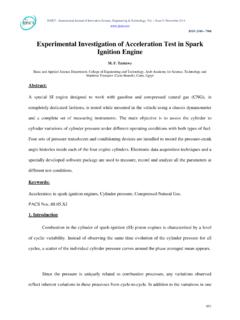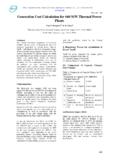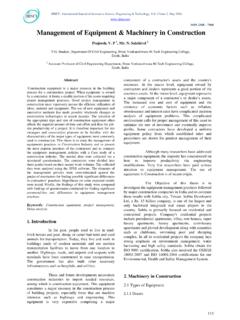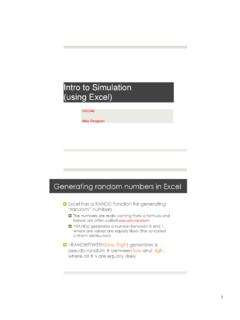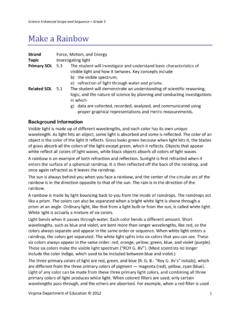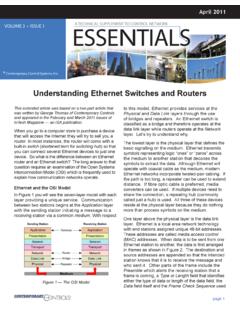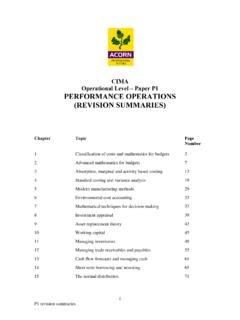Transcription of Modeling of Power System Components During …
1 IJISET - International Journal of Innovative Science, Engineering & Technology, Vol. 1 Issue 10, December 2014. ISSN 2348 7968 Modeling of Power System Components During Electromagnetic Transients 1 Pawe Sowa, 2 Rafa Kumala and 3 Katarzyna uszcz 1, 2 ,3 Faculty of Electrical Engineering, Silesian University of Technology/ Institute of Power Systems and Controls Gliwice, 44-100/ Silesia, Poland Abstract This paper presents a practical approach to electromagnetic transient study. After describing many cases of simulations the Modeling requirements for selected Power System elements are shown. In this paper, there are also compared the results of investigations on correct and incorrect Power System models During electromagnetic transients. Keywords: electromagnetic transients, Power System Modeling , model requirements.
2 1. Introduction The Modeling of modern Power systems is the first and most important step During the analysis of disturbance transients. The main idea of Modeling is to highlight the significant features of the investigated element from the specified phenomena point of view. Due to it, the work connected with the analysis of the research results is accelerated and facilitated. Selected elements designed for Modeling should be assigned to appropriate replacement schemes [1, 4]. At the same time it is important to remember that, During the process of creating those schemes there should be taken into account only those parameters that are important from the analyzed phenomena point of view. Proper selection of System elements is the essence of good Modeling of those Components whose models will be created.
3 This is a very important aspect that should be taken into account because of the huge number and diversity of elements that appears in the contemporary Power systems. Another important aspect is the mapping of real functional connections occurring while creating models. It is also very important to remember that describing the analyzed elements with use of complex mathematical functions and, at the same time, using very simple models for the neighboring elements is incorrect. The most difficult task when constructing models of the Power System is to find a balance between the simplicity of the model and the best representation of real parameters of a given element. The next stage after the Modeling During the process of analyzing the effects of disturbances is to carry out appropriate analyzes of simulation, which should allow for research of the dynamics and properties of the received waveform changes.
4 In practice, due to a very long duration time of particular transient phenomena, the analysis of disturbance has to be done in a narrow time interval. Assuming an appropriate calculation step and time duration of the simulation, it is possible to find hot spots in the test System in a precise way. Fig. 1 shows the way of analyzing the electromagnetic transients and creating the models of elements in the Power System . Fig. 1. Idea of the electromagnetic transient analysis Today there are many types of EMTP software. As a matter of fact, almost all of them have been repeatedly verified in a two ways - by the comparison of the results obtained from different programs, and also with the data from real objects [3, 5]. For the purpose of this paper there was used the most popular simulation program which is EMTP-ATP (Electromagnetic Transients Program - Alternative Transients Program).
5 Identification of the problem Choice of the System Components Creation of the models (replacement scheme + mathematical description) Preparation of the simulation (step calculation, calculation time, the choice of parameters) Analysis and/or verification of the results 715 IJISET - International Journal of Innovative Science, Engineering & Technology, Vol. 1 Issue 10, December 2014. ISSN 2348 7968 In the further part of this paper there are given the recommendations for the proper Modeling of selected System Components . In addition, the results of the analysis of how the model affects the quality of transient disturbances in the real network System During the simulation are presented. 2. Representation of models of selected Power System elements In real systems, the analysis of various types of transient phenomena is complex.
6 That is why simulation models are used. To illustrate the methodology of the process shown in Fig. 1 an attempt was made to focus on the analysis and description of the most common models of elements which appear in Power System . These elements are: Power transformers, Power overhead lines and cables, synchronous generators, induction machines. It is obvious that the studies for other elements of the Power System are performed. However, it should be noted that they less affect the accuracy of mapping the actual state of the tested network System . In order to create a correct representation of the models that are used in the process of simulation, in the first step there should be selected the right parameters and in the next step there should be determined the appropriate operating conditions.
7 For the elements mentioned above there was performed the analysis of different types of disturbances, such as: symmetrical and asymmetrical short circuit in the transmission lines and busbars, switching of unloaded transmission lines, lightning strike to the lightning conductors and working and supporting structures, start up of high Power asynchronous motors and influence of ground short circuit on the main busbars on operation of these machines (several MW), start-up and loss of excitation generators Based on those analysis, the requirements for the System element models listed in the following tables were defined. Marking of electrical characteristics is consistent with the standard IEC 60909-0 and IEC 60909-1 [6, 7]. Table 1: Requirements for the models of lines and cables During the electromagnetic transients Type of the study Model requirements/features Short-circuit Single block model, frequency depends (Marti/ Noda) Open/close operations Single block model, frequency depends (Marti/ Noda), capacity and inductance of neighbors - very important Lightning 7 segments on both sides, frequency depends (Marti/ Noda), pole model: complex (for H > 30 m), surge arrester model - yes, insulator model - not necessary 1) 1) if the surge arrester model is representative Table 2.
8 Requirements for the models of transformers During the electromagnetic transients Type of the study Model requirements/features Open/close operations Simple model - Sr , Xr , Rr (uRr , uXr ) parameters 2) Open/close operations As above + magnetic core characteristics 2) if uRr is unknown, it is possible to determine this parameter based on ratio X/R and parameter Sr ( IEEE St. [8]) Table 3:Requirements for the induction machines During the electromagnetic transients Type of the study Model requirements/features Short-circuit The most important parameter: ILR / Ir Dynamic motor starting analysis During start and load impact/ramp Load characteristic model, kind of the start mode , operation mode of motor Voltage drop As above + include reactors model located to machine 3) and cable connection with significant length 4) 3) the value of reactor impedance is important (particularly for reactors with uKR 4 %) located to the two next nodes (bus) 4) for cables with length above 100 m (it is particularly important for low voltage networks) Table 4: Requirements for the synchronous generators During the electromagnetic transients Type of the study Model requirements/features Short-circuit The most important parameter.
9 ILR / Ir Dynamic motor starting analysis During start and load impact/ramp 1st type of faults 5): the most important parameters - X d and Sr (simple model) 2nd type of faults 6): as above + include armature resistance Ra, stator and rotor winding and dumping circuits (complex model) - represent by suitable time constants in d and q axis Load dump and ramp, voltage changes, loss excitation, start mode Load characteristic, type of generator regulator (which parameters are controlled), type of excitation Island mode As above + include Power protection time settings and sequence of close/open operation 5) for remote faults 6) for close faults 716 IJISET - International Journal of Innovative Science, Engineering & Technology, Vol. 1 Issue 10, December 2014. ISSN 2348 7968 3. Analysis of impact of models on selected electromagnetic transient phenomena For the purposes of this paper, the most commonly types of disturbances occurring in a modern Power System were examined.
10 The System Components which influence the System operation in the deciding way were analyzed. The results of the analysis are summarized in Tables 1 to 4 (see Section 2). The investigations were performed for the real part of the Power System . The most important elements of the modeled System During electromagnetic transient include: monorail lines 220 kV with lengths from several several tens of kilometers, block transformers and synchronous generators with Power ratings of at least 190 MVA, asynchronous machines of high Power (above MW). As an example which shows the effect of the proper models selection of the System , there was chosen a skew three-phase short circuit at the end of the 220 kV lines with a length about 92 km (Line1). The final transients waveforms were observed on the BUS 14 220 kV.




